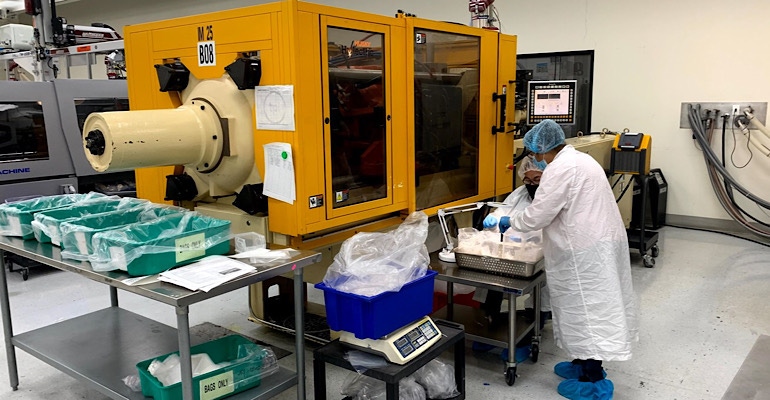Increased competition among packaging companies means that creating and strengthening alliances and partnerships with a broad base of medical manufacturers will be core to achieving growth.
February 9, 2023

From protecting products against damage and contamination to ensuring that information and instructions are accurate, packaging is a critical component of any medical device offering. Its importance is reflected by the continued expansion of the medical device packaging market, which Markets & Markets projects will reach $15.3 billion by 2027, reflecting a compound annual growth rate (CAGR) of 5.3% for 2020-2027.
The growing market represents both challenges and opportunities for medical packaging manufacturers. Notably, medical device companies increasingly rely on multiple packaging providers to reduce risk, gain cost savings associated with logistics, achieve greater quality control, and have faster access to new packaging innovations. The increased competition among packaging companies means that creating and strengthening alliances and partnerships with a broad base of medical manufacturers will be core to achieving growth.
At the same time, those manufacturers who are staying at the forefront of advances in medical packaging can compete on their ability to make a direct, lasting contribution to medical device companies’ success by improving time-to-market on new products and reliably meeting customer delivery dates while achieving sustainability goals. Increasingly, the ability to drive these advances is based on a foundation of continual improvements in precision manufacturing.
Let’s first look at the key market requirements that medical packaging manufacturers need to address to remain competitive and then examine the approaches to precision manufacturing that can support these efforts.
Quality and Compliance Drive Competition in Medical Packaging
To be competitive, medical packaging manufacturing face challenges that are similar to less regulated industries, including reliable, on-time delivery; faster innovation cycles, and greater cost-efficiency. However, strength in these areas is not enough if packaging providers don’t also meet medical device manufacturers’ requirements for consistent quality and compliance.
The chief operating officer (COO) at a medical device manufacturing firm said it best, “Quality is the currency we trade-in, and it's worth it to us to find a packaging provider who is always innovating on that dimension first. Driving cost reductions on our side with production improvements is always happening; we can't take a chance on mediocre packaging; it has to be excellent to stay in compliance.”
To compete in the medical device industry, packaging manufacturers should invest in four areas of compliance in particular.
The International Standards Organization (ISO) 11607-1:2019 standard, “Packaging for Terminally Sterilized Medical Devices – Part 1,” specifies requirements and test methods for materials, preformed sterile barrier systems, sterile barrier systems, and packaging systems that are intended to maintain sterility of terminally sterilized medical devices until the point of use. Testing methods include visual inspection, bubble leak tests, and microbe challenge tests that examine the seal integrity and strength of the packaging.
ISO 11607-2:2019, “Packaging for Terminally Sterilized Medical Devices – Part 2,” specifies requirements for the development and validation of processes for packaging medical devices that are terminally sterilized. These processes include forming, sealing, and assembly of preformed sterile barrier systems, sterile barrier systems, and packaging systems. It is applicable anywhere medical devices are packaged and sterilized.
FDA has established the Unique Device Identification System final rule (UDI Rule), which aligns with the unique device identification system developed by FDA to adequately identify medical devices sold in the United States from manufacturing through distribution to patient use. It requires device labelers to include a UDI on device labels and packages — except where the rule provides for an exception or alternative—and submit device information to the Global Unique Device Identification Database (GUDID).
The International Medical Device Regulators Forum (IMDRF) is a group of medical device regulators from around the world that have voluntarily come together to harmonize the regulatory requirements for medical products that vary from country to country. Among other guidelines, it provides “Principals of Labelling for Medical Devices and IVD Medical Devices.”
Precision Manufacturing Advances Support Competitive Goals
With rapid advancements in precision manufacturing, medical packaging providers are discovering new ways to ensure quality and compliance by optimizing clean room operations, increasing the accuracy of lot serialization, improving packaging sustainability, and adopting more efficient machinery and processes. In particular, when packaging is produced at the highest precision possible, medical packaging manufacturers can ensure overall product quality while lowering costs by reducing returned material authorizations (RMAs) due to ineffective packaging. At the same time, precision manufacturing is key to helping packaging producers support medical device manufacturers’ environmental, social, and governance (ESG) goals.
Following are the latest precision manufacturing techniques that packaging manufacturers can employ to excel in becoming trusted partners to medical device companies.
Optimize Cleanroom Operations
Optimizing cleanroom operations to improve medical packaging production has numerous benefits. First, it helps to increase production efficiency by streamlining processes and improving throughput. Second, it enables greater accuracy and quality control, as every process step can be closely monitored in real-time. Third, it reduces the risk of contamination due to the implementation of effective sanitization protocols. Finally, it allows for automated production, which helps to reduce labor costs, increase productivity, and improve safety and compliance.
Medical packaging manufacturers are turning to lean and precision manufacturing techniques to identify the best possible mix of available technical expertise, materials availability, and machinery yield rates by clean room facility. Those companies running an integrated, real-time manufacturing system at these facilities further ensure quality while achieving the most cost-effective and efficient production of medical packaging.
Align Cleanroom Sterilization and Lot Serialization
Medical packaging manufacturers require cleanroom sterilization and lot serialization to ensure that their products meet the strict safety and quality standards demanded by regulatory agencies and the medical manufacturers they serve.
The clean room sterilization process reduces the number of airborne particles to an acceptable level and creates a sterile environment for product manufacturing, testing, and storage. Medical packaging manufacturers are seeing their fastest growth in providing cleanrooms that can deliver large-scale production runs of sterilized containers. Precision manufacturing supports this demand by using advanced technology to manufacture packaging with high accuracy, consistency, and repeatability levels.
Meanwhile, lot serialization allows for tracking products from their source to the end user, ensuring that each product is correctly identified, monitored, and traced. Here, precision manufacturing offers a higher degree of control over the process, and by automating serialization, packaging manufacturers can more readily stop any potential counterfeiting.
Invest in Sustainability Initiatives
As regulators and consumers focus on the environmental impact of packaging and supporting production processes, medical device manufacturers and their suppliers are under pressure to make their packaging more sustainable. Investing in more energy-efficient machines is one-way packaging producers can reduce their carbon footprint and operating costs contributing to sustainability. However, far greater sustainability gains come from identifying and addressing issues in each packaging production process that lead to wasted resources, materials, and time.
The most common and significant issue in production is the use of excessive medical packaging, which can lead to increased material costs, decreased productivity, and even product damage—in addition to leaving a greater footprint on the environment. Other gaps include excess scrap arising from production or process issues, water waste, and inefficient use of non-renewable energy sources.
Precision manufacturing can help to close the gaps in achieving sustainability goals. For example, real-time monitoring can be used to identify when packaging production is moving outside approved parameters or when a machine’s performance is beginning to decline—indicating the need for maintenance before it affects the quality of packaging produced. Additionally, track and track functionality can be used to identify to ensure the compliance of incoming materials, as well as the medical product packaging being produced and delivered.
The most forward-thinking medical packaging manufacturers are prioritizing the sustainable design of high-quality packaging based on sustainable materials to reduce waste, save energy, and increase efficiency. From the first concept designs through the first production run, the sustainable design allows for a leaner, more precise production process that reduces an organization's long-term impact on the environment while driving profitability.
Conclusion
In an increasingly crowded market, medical packaging manufacturers need to keep innovating faster than their competitors to maintain lucrative relationships with medical manufacturers. And above all, quality is key for packaging producers to maintain the loyalty and business of the medical device manufacturers they serve. Successful medical packaging companies are utilizing advances in precision manufacturing to reduce costs, improve product quality, and meet customer satisfaction goals. In doing so, they are also discovering new ways to reduce compliance and product safety risks, optimize clean room operations, and pursue sustainable design initiatives to meet ESG goals better.

Louis Columbus, Enterprise Software Strategist
Louis Columbus is currently serving as principal of DELMIAWorks. Previous positions include product management at Ingram Cloud, product marketing at iBASEt, Plex Systems, senior analyst at AMR Research (now Gartner), marketing and business development at Cincom Systems, Ingram Micro, a SaaS start-up and at hardware companies.
About the Author(s)
You May Also Like




